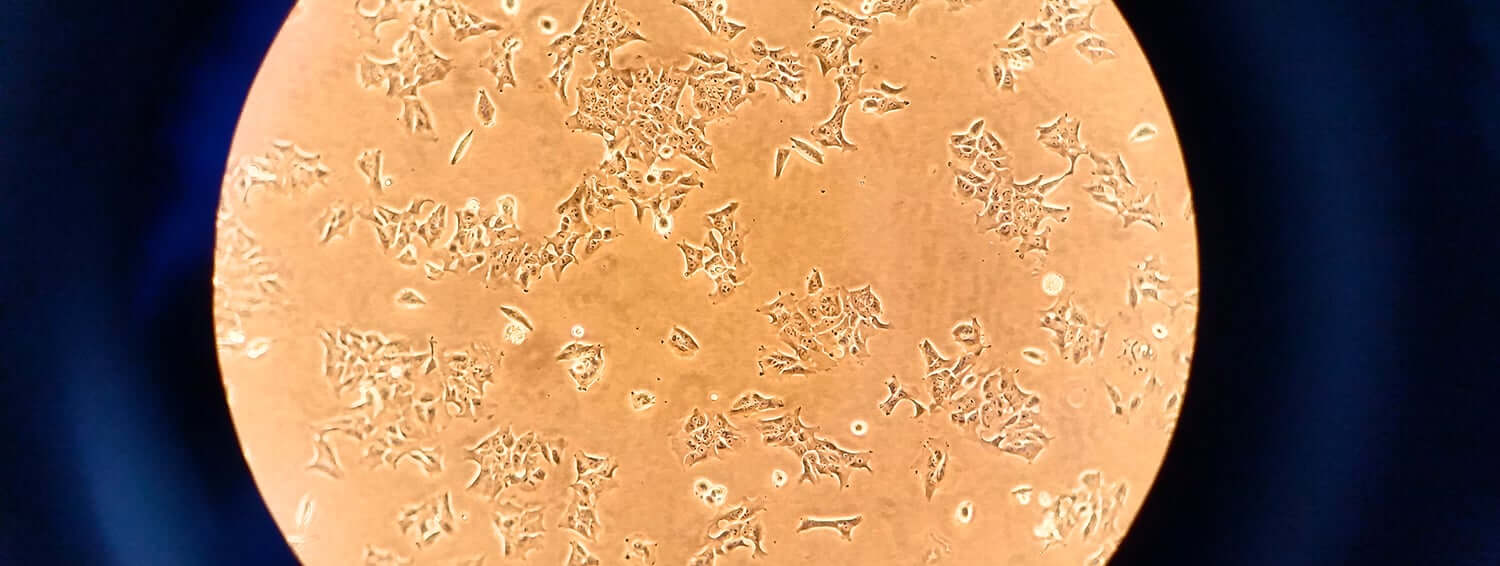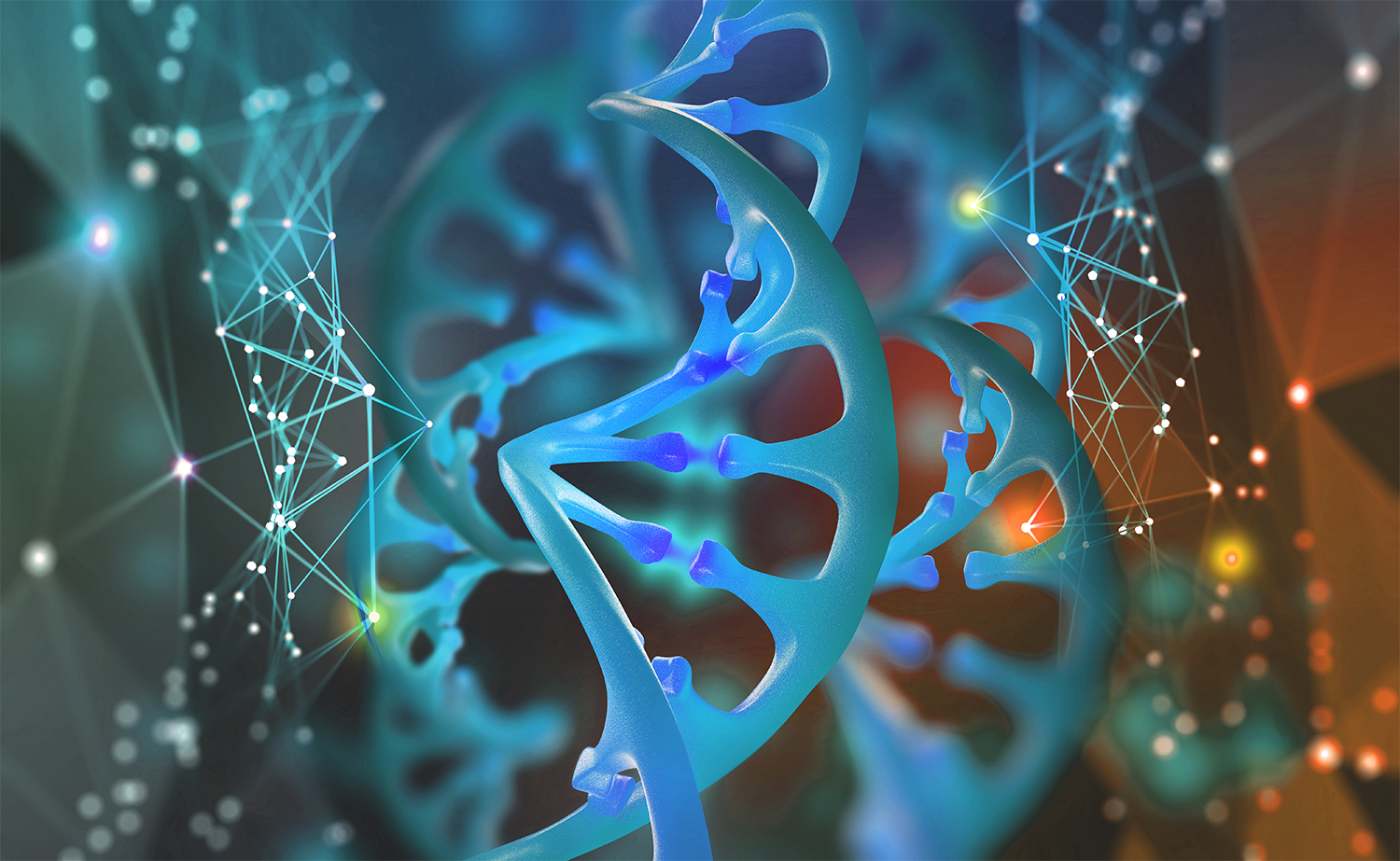This post explores applications of genetically engineered organoids and cell lines to expand and accelerate anti-cancer drug discovery and development. We first provide a brief overview of two major methods that are used to develop engineered organoids/cell lines (i.e., lentiviral transduction and PiggyBac), followed by typical workflows for generating these models. Several case studies are presented to showcase their application for target validation and in vitro /in vivo efficacy studies.
Why Use Genetically Engineered Organoids and Cell Lines?
Cell lines and organoids can be readily engineered to stably express transgenes, reporter constructs, and targeted genetic alterations. These modifications greatly expand the application of these models. For instance, tumor organoids engineered to express a bioluminescent probe can be used to establish an orthotopic patient-derived xenograft (PDX), allowing for visualizing the tumor response to treatment in real time and evaluating the response in a relevant tumor environment (TME).
Further, specific genetic mutations known to be underrepresented in patient populations can be introduced, thereby generating highly clinically relevant preclinical models that would otherwise not exist. Additionally, development of panels of organoid models featuring specific mutational profiles can facilitate identifying a target patient population and developing precision medicine approaches.
Genetically engineered in vitro models are increasingly being used to enable the following types of studies relevant to drug discovery and development:
- Mechanism of action
- Target discovery/validation
- Drug resistance
- Treatment response via reporter lines
Two Methods Used to Generate Genetically Engineered In Vitro Models
A variety of published methods can be used to produce stably expressing engineered models. Below we describe two commonly used methodologies: Lentiviral transduction and PiggyBac. These platforms can be used to develop a wide array of engineered models, including:
- Standard/inducible over-expression
- Standard/inducible knockdown
- Knockout
- Knock-In
CRISPR/Cas9 gene editing is also being used in both platforms. This versatile and highly efficient technology has opened enormous possibilities for targeted genetic engineering of mammalian organoid and cell line models, specifically for inducing specific genetic alterations.
The following figure depicts the general process for developing engineered organoids.
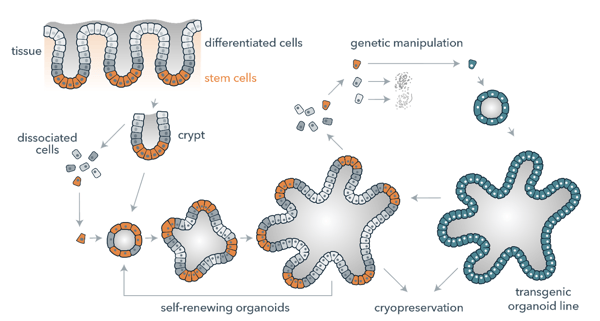
By targeting single stem cells, transgenic organoids can be derived via clonal expansion and cryopreservation (green). In contrast, differentiated cells cannot form new organoids. From Menche & Farin. Strategies for genetic manipulation of adult stem cell-derived organoids. Experimental & Molecular Medicine volume 53, pages 1483–1494 (2021). Available at https://www.nature.com/articles/s12276-021-00609-8. Used under Creative Commons Attribution 4.0 International License: https://creativecommons.org/licenses/by/4.0/
Lentiviral Transduction
Lentiviral transduction is recognized as a highly efficient method for stable modification of both organoids and cell lines. Lentiviruses do not require cell division for transduction, and they integrate their genome into the infected host cells’ genome. This technology is used across a wide array of applications including for the delivery and stable expression of transgenes, small hairpin RNA (shRNA) constructs, and single-guide RNA (sgRNA) expression cassettes that target sequences via CRISPR/Cas9 gene editing.
Several possible challenges should be taken into consideration prior to using the lentiviral transduction method. The random insertion of the viral genome into the host genome can lead to the unpredictable disruption of endogenous genes (albeit to a lesser degree compared to onco-retroviruses), a variable number of integrations, and generally, lentiviral vectors are limited to DNA sequences up to ~8kb. Beyond this size, viral titers may be reduced substantially.
PiggyBac
This is a non-viral platform that is designed as a two-plasmid system where one contains the expression cassette (the transposon) and the other contains the coding region of the PiggyBac transposase to facilitate the integration of the transposon specifically at ‘TTAA’ tetranucleotide sites dispersed across the genome. The following image illustrates the mechanism of PiggyBac transposition.
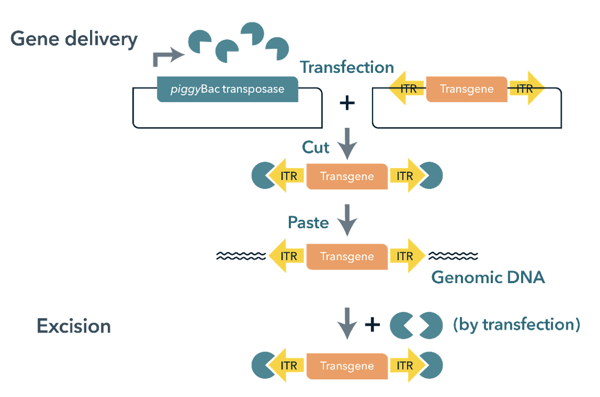
Mechanism of piggyBac transposition. (a) In the transfected cell, transposase is expressed from the piggyBac transposase expression vector, and it then recognizes and binds to the specific inverted terminal repeats (ITRs) of the transgene vector plasmid and cuts the DNA sequence of the transgene from the original sites. Then, the transgene DNA sequence integrates into the genomic DNA of the target cell. (b) For excision, re-expression of transposase by transfection of the piggyBac transposase expression vector leads to cutting of the transgene at the ITRs in the genomic DNA, which results in removal of the inserted transgene from the genomic DNA. From Zhang, M., et al. (2017). Gene Delivery and Expression Systems in Induced Pluripotent Stem Cells. In: Sasaki, K., Suzuki, O., Takahashi, N. (eds) Interface Oral Health Science 2016. Springer, Singapore. Available at https://doi.org/10.1007/978-981-10-1560-1_11. Used under Creative Commons Attribution 4.0 International License: https://creativecommons.org/licenses/by/4.0/
PiggyBac was first used to generate engineered mammalian cells in 2005, and it was shown to be capable of achieving stable expression of large inserts (up to 14 kb) without decreases in transposition efficiency. Like lentiviruses, this system is also used across a wide array of applications including to facilitate target gene editing via CRISPR/Cas9. PiggyBac is also suitable for use in cells that are difficult to be transduced.
PiggyBac delivers a fully intact genetic cargo into the host genome, allows for multiple transgenes to be stably delivered and expressed, and the number of integration copies can be regulated by titrating the transposon to transposase ratio. There are several potential challenges with PiggyBac including the possibility of introducing mutations into endogenous genes and controlling the copy number in clones.
Typical Workflow for Generating Engineered Models
Typical timelines for producing genetically engineered organoids and cell lines ranges between 16-32 weeks and 11-15 weeks, respectively. The workflows shown below illustrate the major steps and approximate timing of each step involved in the production of the respective engineered models. The variability in timing is related to several factors, including the model system, DNA modification platform, and design and optimization of parameters. The main steps in each workflow include:
- Plasmid Design
- Transfection or Transduction
- Clone Selection and Validation
- Cell Line Delivery
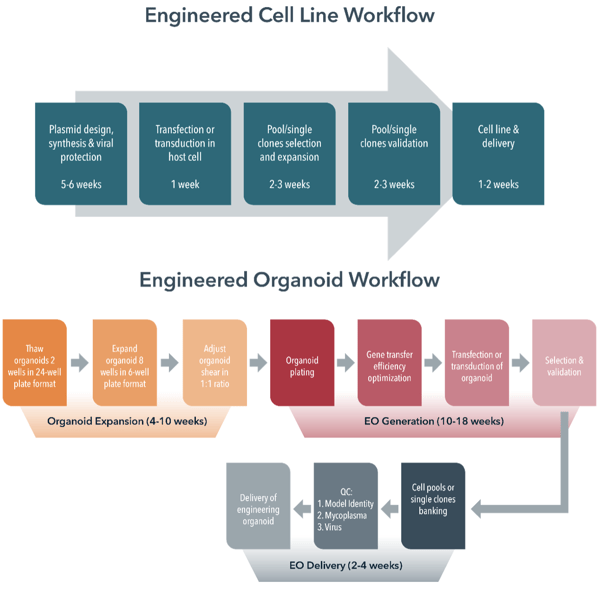
Case Studies
Development of EGFR-Del19-T790M-C797S Resistant Cell Line (Lentiviral Transduction)
PC-9 is a lung adenocarcinoma cell line with a deletion in exon 19 of the EGFR gene. As shown in the schematic below, an engineered PC-9-based cell line was developed to overexpress EGFR-Del19-T790M-C797S, one of the most prevalent EGFR mutants identified in osimertinib (AZD9291)-resistant tumors.
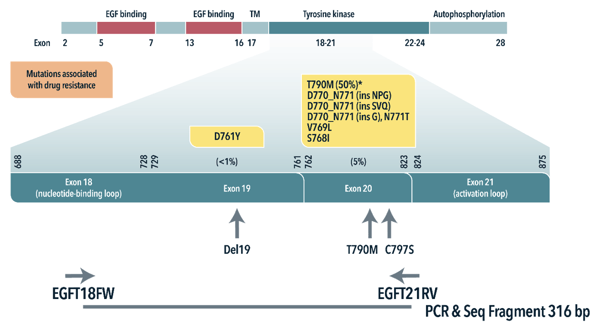
Clones were developed and validated using several assays including genetic sequencing. Four clones were selected for further analysis, two medium and two high expression level clones. As shown in the graph below, overexpression of EGFR-Del19-T790M-C797S conferred cell resistance to osimertinib (AZD9291). Read our previous post discussing the preclinical assessment of osimertinib for NSCLC with EGFR exon 20 insertions.
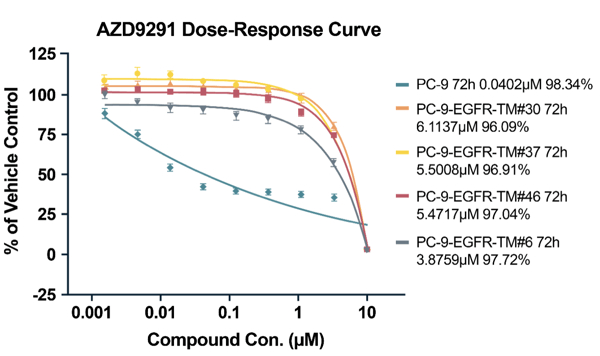
Inducible Gene Knockdown via shRNA (Lentiviral Transduction)
An inducible gene knockdown model was developed in the U2OS cell line. As shown in the image below, the shRNA (shX) successfully knocked down “Target X” in the presence of the inducer doxorubicin (“Doxy”) [see red boxes] beginning at the first timepoint of 24 hours. Subsequent analyses showed that the knockdown of target X significantly inhibited cell growth compared with the negative control group (shNT).
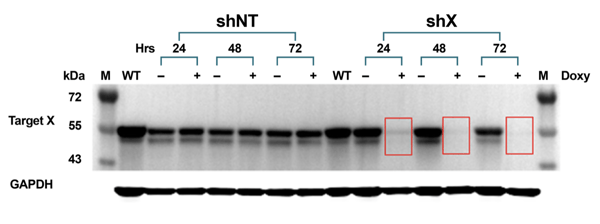
A20-hROR1 (PiggyBac)
After observing that lentiviral transduction in the A20 cell line was inefficient (i.e., low cell viability in the presence of antibiotic selection), hROR1 was successfully introduced into the A20 cell line using PiggyBac. As shown below, a variety of clones with varying hROR1 expression levels were successfully produced. This valuable model can be used to evaluate hROR1-targeted immuno-therapies, and it is currently undergoing in vivo validation.
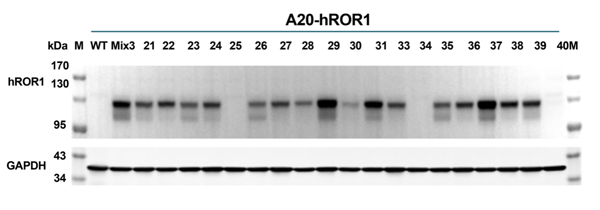
STK11 Knockout in MC38 by CRISPR (PiggyBac)
The STK11 gene (LKB1) was successfully knocked out in the murine colorectal carcinoma cell line CT26 using CRISPR gene editing via PiggyBac. In vivo validation studies demonstrated that this engineered cell line had significantly faster tumor growth and PD1 efficacy was abolished in the STK11 knockout CT26 model as compared to the parental cell line.
Furthermore, the combination of trametinib and an anti-PD1 agent produced significant antitumor activity against the CT26-STK11 knockout model as shown via linear mixed model analysis (p=0.035 vs. control group).
Liver Cancer Organoid (PDXO LI6677) Engineered to Express Human CD19 and Luciferase
The LI6677 organoid line was engineered to express the human immune cell target CD19 in combination with the reporter luciferase to allow for quantitative evaluation of the antitumor effects of a CD19 CAR-T immunotherapy. To do this, the engineered organoids were co-cultured with the CD10 CAR-T cells over a period of 48 hours and luciferase activity revealed specific killing of tumor organoids by CD19 CAR-T cells.
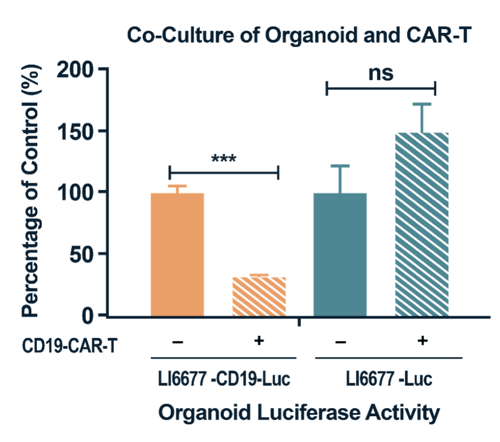
Conclusion
Organoids and cell lines expand the number of in vitro models available for drug discovery purposes. The application of genetically engineered organoids and cell lines can benefit a wide array of preclinical studies, and with the appropriate level of upfront planning, these models have the potential to enhance the translatability of preclinical data. Prior to generating an engineered model, it is highly advisable to hold early discussions with experts in engineered in vitro models, including experts with a deep understanding of how to circumvent any potential pitfalls so that your model and downstream studies are positioned for success.
Crown Bioscience has extensive experience with engineered organoids and cell lines, and we currently offer 26 engineered organoid models that cover multiple cancer types and can be applied in multiple types of studies, including in vivo imaging, immunotherapy and mechanism of action studies.

